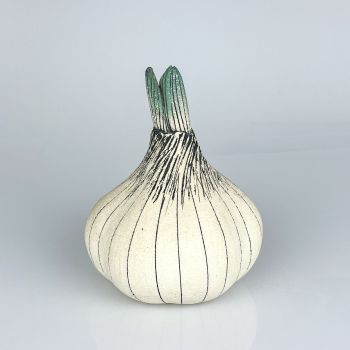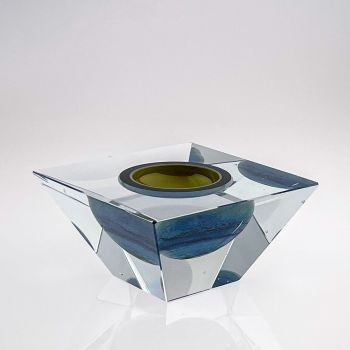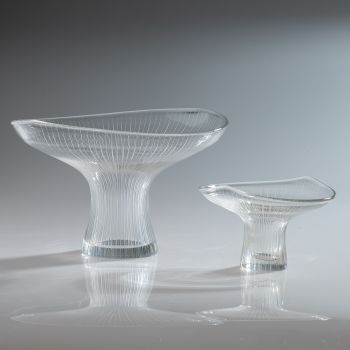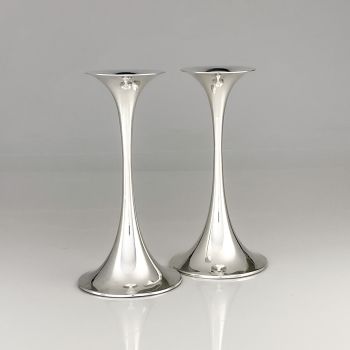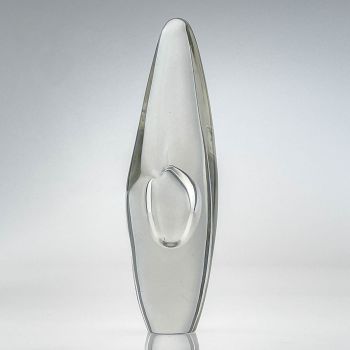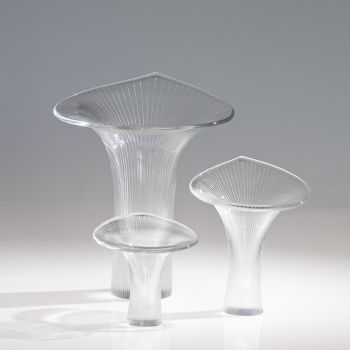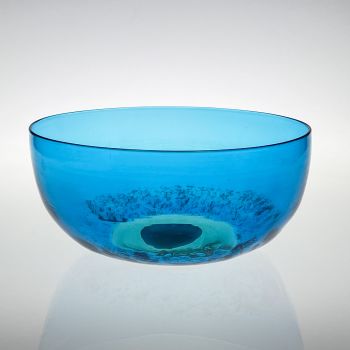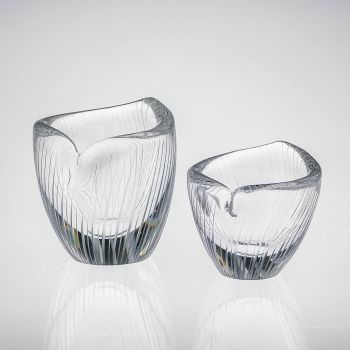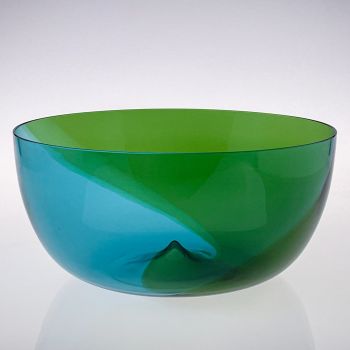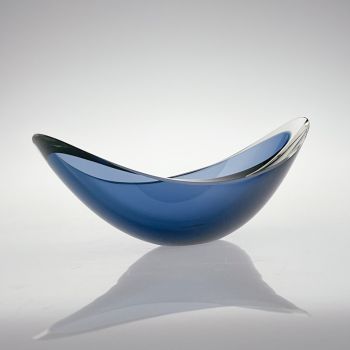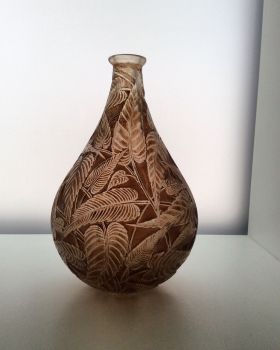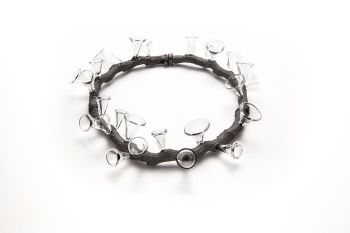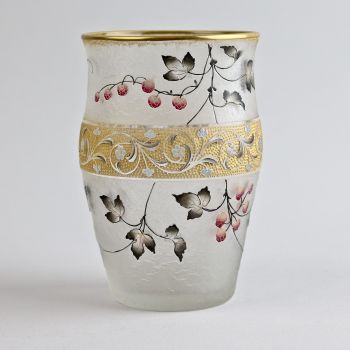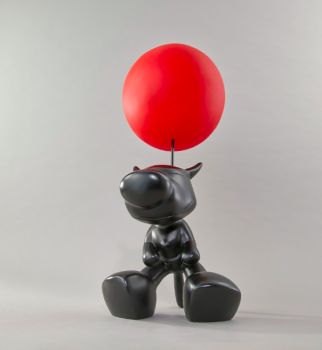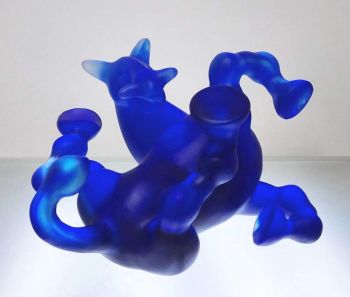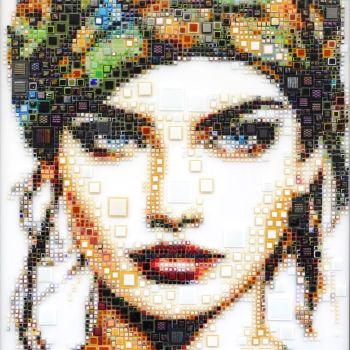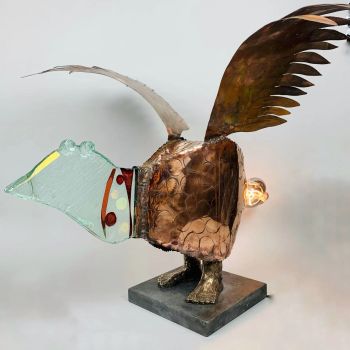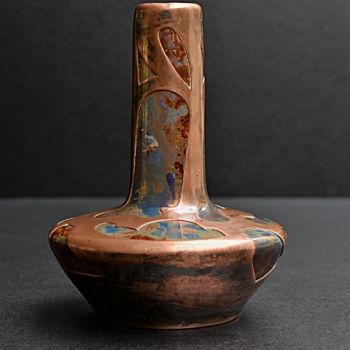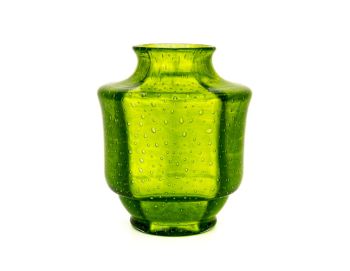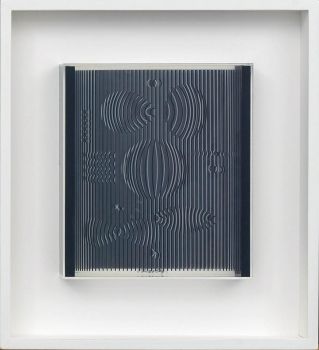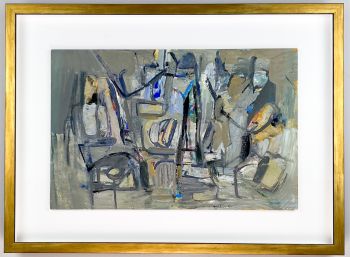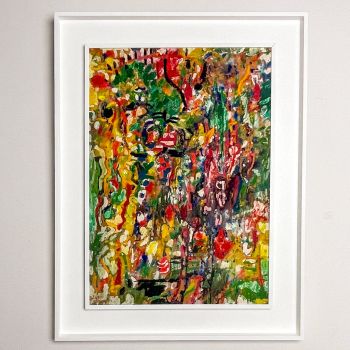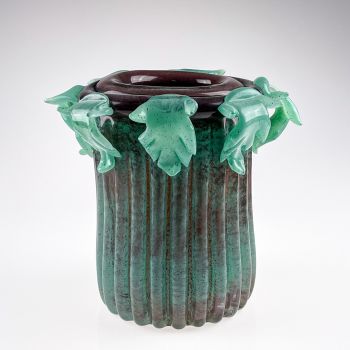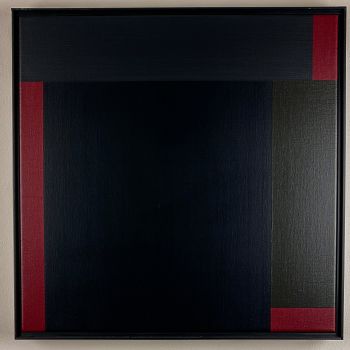A set of two sizes Art-object, model SH 117, Nuutajärvi-Notsjö Finland 1958 & 1959 1958 - 1959
Saara Hopea
Copo
5 cm, ø 13 cm
ConditionVery good
€ 1.100
Van Kerkhoff Art
- Sobre arteTwo mold-blown, clear, dark-blue and moss-green cased glass Art-objects / bowls, model SH 117. Designed by Saara Hopea in 1956 and executed by Nuutajärvi-Notsjö in 1958 & 1959.
An optical effect makes it appear as if the colour goes to the outer edges but the encasing is only in the interior.
These objects were made between 1956 and 1967 in two sizes 9,5 cm and 13,5 cm in diameter, and in several colours (blue, green, yellow, purple and red) this being a complete set in green and blue. Both are early production examples.
They are marked and dated in diamond pen underneath the base.
Two mold-blown, clear, dark-blue and moss-green cased glass Art-objects / bowls, model SH 117. Designed by Saara Hopea in 1956 and executed by Nuutajärvi-Notsjö in 1958 & 1959.
An optical effect makes it appear as if the colour goes to the outer edges but the encasing is only in the interior.
These objects were made between 1956 and 1967 in two sizes 9,5 cm and 13,5 cm in diameter, and in several colours (blue, green, yellow, purple and red) this being a complete set in green and blue. Both are early production examples.
They are marked and dated in diamond pen underneath the base.
About Saara Hopea
Saara Elisabet Hopea (Porvoo 1925 – Porvoo 1984) was a Finnish designer of Art-glass, furniture and jewellery.
Saara Hopea was born in 1925 in Porvoo, in the south of Finland. Her parents Ossian Hopea and Lempi Westerlund owned a goldsmithing company.
After attending secondary school, Hopea studied at the Interior Design Department of the Central School of Art and Design, now the Aalto University of Art and Design.
She graduated in 1946, and worked for a few years as an illustrator, then she accepted a job at the lighting factory of Taito Oy, headed by the renowned designer Paavo Tynell.
In the early 1950’s, Saara Hopea became interested in glass design and started working at the Nuutajärvi glass factory, where she worked under artistic director Kaj Franck.
After her father’s death, Saara Hopea took over the direction of the family business Ossian Hopea Oy in 1959. She worked as the artistic director from 1959 to 1960 and again from 1967 and was responsible for numerous jewellery designs.
In 1960 Saara Hopea married Oppi Untracht , an American goldsmith, photographer and writer, and they moved to New York City. Together with her husband, Saara Hopea also lived in Nepal and in India over the years until 1967, after which the couple settled permanently in Porvoo.
For her glass designs, Saara Hopea received a silver medal at the Milan Triennials in both 1954 and 1957. She also received the Porvoo City Culture Prize in 1981 and the State Arts and Crafts Prize in 1982.
Her retrospective exhibition was held at the Museum of Arts and Crafts in Helsinki in 1987. 28 of her works are in the collection of The British Museum in London and the MoMa in New York holds 11 of her works.
About Saara Hopea
Saara Elisabet Hopea (Porvoo 1925 – Porvoo 1984) was a Finnish designer of Art-glass, furniture and jewellery.
Saara Hopea was born in 1925 in Porvoo, in the south of Finland. Her parents Ossian Hopea and Lempi Westerlund owned a goldsmithing company.
After attending secondary school, Hopea studied at the Interior Design Department of the Central School of Art and Design, now the Aalto University of Art and Design.
She graduated in 1946, and worked for a few years as an illustrator, then she accepted a job at the lighting factory of Taito Oy, headed by the renowned designer Paavo Tynell.
In the early 1950’s, Saara Hopea became interested in glass design and started working at the Nuutajärvi glass factory, where she worked under artistic director Kaj Franck.
After her father’s death, Saara Hopea took over the direction of the family business Ossian Hopea Oy in 1959. She worked as the artistic director from 1959 to 1960 and again from 1967 and was responsible for numerous jewellery designs.
In 1960 Saara Hopea married Oppi Untracht , an American goldsmith, photographer and writer, and they moved to New York City. Together with her husband, Saara Hopea also lived in Nepal and in India over the years until 1967, after which the couple settled permanently in Porvoo.
For her glass designs, Saara Hopea received a silver medal at the Milan Triennials in both 1954 and 1957. She also received the Porvoo City Culture Prize in 1981 and the State Arts and Crafts Prize in 1982.
Her retrospective exhibition was held at the Museum of Arts and Crafts in Helsinki in 1987. 28 of her works are in the collection of The British Museum in London and the MoMa in New York holds 11 of her works.
Marked
Marked in diamondpen underneath the base: S. Hopea Nuutajärvi-Notsjö '59 (1959) & '58 (1958)
Execution
Nuutajärvi-Notsjö glassworks, Finland 1958 & 1959
Condition
These Art-objects are in good vintage condition. Some scratches on the side and several deeper scratches underneath the base. Basic wear consistent with age and use. No chips or cracks.
Literature
Oppi Untracht – Saara Hopea-Untracht: her life and work.
Dimensions
Height 5,16 & 4,42 cm
Diameter 13,56 & 10,6 cm
Weight 1443 & 775 grams - Sobre artista
Saara Hopea teve uma carreira prolífica em vários campos do design, deixando uma marca significativa na paisagem artística finlandesa da década de 1950. Sua jornada começou no mundo do design de móveis, onde aprimorou suas habilidades de 1946 a 1948. Em busca de novas oportunidades, juntou forças com a empresa do renomado serralheiro Paavo Tynell, onde trabalhou até 1952.
Durante esse tempo, ela contribuiu para a vidraria Nuutajärvi, onde suas criações se tornaram uma brilhante personificação da estética minimalista que definiu o estilo finlandês na década de 1950, influenciada pelos princípios da filosofia de design Bauhaus. Notavelmente, após a morte de seu pai em 1948, ela assumiu a tarefa de projetar talheres para sua loja em Porvoo.
Uma virada na vida de Hopea ocorreu quando ela se casou e se mudou para Nova York com o marido. Foi aqui que iniciou um novo percurso artístico, explorando o universo do trabalho com esmalte. Através de sua experimentação com esmaltes transparentes sobre queima sobre cobre, ela alcançou resultados notáveis que conferiram às suas peças uma aparência espontânea e pictórica, caracterizada por cores vibrantes e profundidade notável. Suas requintadas criações de esmalte chegaram às mãos de clientes exigentes por meio de lojas exclusivas.
A sede de conhecimento e inspiração artística do casal os levou a embarcar em uma viagem marcante pelo Nepal e Índia, ao longo de quatro anos. Durante esse tempo, eles mergulharam no estudo, fotografia e coleção de ourivesaria e joias locais. Em 1997, seu marido, profundamente influenciado por suas experiências, publicou "Joias Tradicionais da Índia", um testemunho de sua exploração e apreciação da rica herança artística da região. Em 1967, eles retornaram a Porvoo, onde os empreendimentos artísticos de Hopea abrangeram uma ampla gama de disciplinas, incluindo ourivesaria, design têxtil e esmaltação.
O impacto do talento e arte de Saara Hopea se estende além das fronteiras da Finlândia. O Museu Britânico possui uma coleção de 28 de suas obras, enquanto o Museu de Arte Moderna possui 11 itens preciosos, testemunho de seu legado duradouro. Em 1988, seu marido publicou um relato abrangente de sua vida e obra intitulado "Saara Hopea-Untracht: Life and Work", iluminando a notável jornada artística dessa tranquila visionária escandinava.
Você está interessado em comprar esta obra de arte?
Artwork details
Related artworks
- 1 - 4 / 24
- 1 - 4 / 24
- 1 - 4 / 24
Victor Vasarely
"Venus", multiple 1987 - professionally framed, museumglass1987
€ 3.700Van Kerkhoff Art
 Com curadoria de
Com curadoria deDanny Bree
1 - 4 / 12






